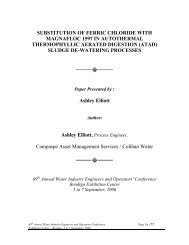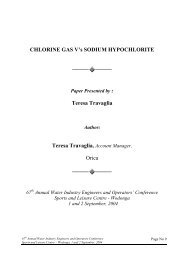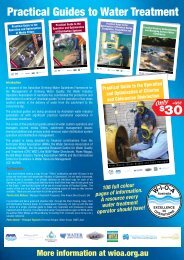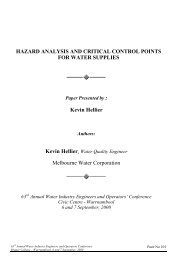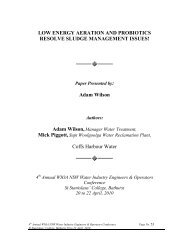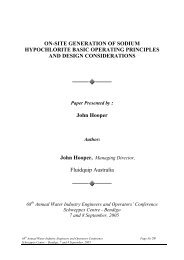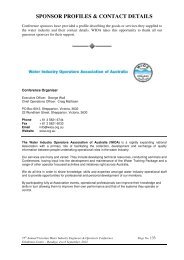SODIUM HYPOCHLORITE PORTABLE DOSING UNIT Max ... - WIOA
SODIUM HYPOCHLORITE PORTABLE DOSING UNIT Max ... - WIOA
SODIUM HYPOCHLORITE PORTABLE DOSING UNIT Max ... - WIOA
You also want an ePaper? Increase the reach of your titles
YUMPU automatically turns print PDFs into web optimized ePapers that Google loves.
<strong>SODIUM</strong> <strong>HYPOCHLORITE</strong> <strong>PORTABLE</strong> <strong>DOSING</strong><br />
<strong>UNIT</strong><br />
Paper Presented by:<br />
<strong>Max</strong> Hadzidimitriou<br />
Authors:<br />
<strong>Max</strong> Hadzidimitriou, Project Manager,<br />
David Younger, Water Quality Engineer,<br />
Yarra Valley Water<br />
73 rd Annual Water Industry Engineers and Operators’ Conference<br />
Bendigo Exhibition Centre<br />
31 August to 2 September, 2010<br />
73rd Annual Victorian Water Industry Engineers & Operators Conference Page No. 4<br />
Exhibition Centre – Bendigo, 31 August to 2 September, 2010
<strong>SODIUM</strong> <strong>HYPOCHLORITE</strong> <strong>PORTABLE</strong> <strong>DOSING</strong> <strong>UNIT</strong><br />
<strong>Max</strong> Hadzidimitriou, Project Manager, Yarra Valley Water<br />
David Younger, Water Quality Engineer, Yarra Valley Water<br />
ABSTRACT<br />
Yarra Valley Water’s 2013 Strategy includes a key objective on the safety and wellbeing of its<br />
staff and contractors. As part of implementing this strategy and achieving ongoing improvements<br />
in occupational health and safety, Yarra Valley Water has undertaken a review of its emergency<br />
response chlorination practices and identified a significant improvement opportunity.<br />
Historically operators have had to work from heights to spot dose tanks with sodium<br />
hypochlorite, which has potential for an unsafe combination of working from heights and<br />
chemical handling. Yarra Valley Water together with its civil contractor Bilfinger Berger<br />
Services and Jonoco Pty Ltd developed a Portable Dosing Unit which endeavours to mitigate or<br />
remove these hazards from field spot dosing activities.<br />
The Portable Dosing Unit also offers a more accurate and effective process to spot dose<br />
reservoirs or water mains. It utilises flow measurement to volumetrically inject a specified<br />
volume of sodium hypochlorite solution into a Reservoir inlet to facilitate even mixing and<br />
reduce the potential for chemical short-circuiting. This approach to emergency disinfection<br />
enables Yarra Valley Water to respond promptly and efficiently to emergency water quality<br />
events and ensure that our contractors can work in a safe and practical manner.<br />
KEY WORDS<br />
Sodium Hypochlorite, Trailer, Injection, Potable, Tanks, Dosing, Safety<br />
1.0 INTRODUCTION<br />
Yarra Valley Water is one of three metropolitan retailers and supplies water and<br />
sewerage services to over 650,000 customers in the north and east of Melbourne. Yarra<br />
Valley Water’s 9,500 kilometres of distribution and reticulation water supply is varied in<br />
its geographical features, age and condition: the water supply system distributes filtered<br />
and unfiltered supplies to 31 Water Quality Zones which includes 168 different pressure<br />
zones. The variable operation of these 168 pressure zones, which contain 52 tanks, 108<br />
pressure reducing valve stations and 65 pump stations, can substantially affect water<br />
quality for the customer. In some instances emergency disinfection is required to rectify<br />
taste and odour issues and respond to microbiological detections.<br />
Emergency disinfection has historically involved conducting spot dosing of water service<br />
reservoirs and elevated tanks with sodium hypochlorite. Volumes of the chemical<br />
required to spot dose any one reservoir will vary from as little as 0.2 Litres up to 150<br />
Litres. Operators would utilise fall prevention devices to climb tanks at heights of 4<br />
meters up to as much as 30 meters to dose the chlorine through an entry hatch. Although<br />
the right safety measures can be utilised to provide a relatively safe working<br />
environment, it does not eliminate all hazards. For anyone working in this way, it is still<br />
an awkward and inaccurate way to conduct disinfection.<br />
Initially, Yarra Valley Water began a scoping process with its civil maintenance<br />
contractors Bilfinger Berger Services (BBS), which conducts the spot dosing, to identify<br />
key features to be included in the design of a Portable Dosing Unit (PDU).<br />
73rd Annual Victorian Water Industry Engineers & Operators Conference Page No. 5<br />
Exhibition Centre – Bendigo, 31 August to 2 September, 2010
Jonoco Pty Ltd and I&AC Services Pty Ltd were commissioned to assist with the design<br />
and fabrication of the PDU. Their contribution to the project was enhanced due to the<br />
previous experience they had in designing similar emergency dosing trailers and<br />
chlorinators for Melbourne Water, which proved to be the basis for Yarra Valley Water’s<br />
design.<br />
2.0 DISCUSSION<br />
2.1 Design Scope<br />
To become an effective and well utilised tool, it was decided to retrofit a trailer for ease<br />
of operation and meet some basic functional requirements (Figure 1). A trailer was<br />
chosen instead of a skid mounted unit on the back of a Ute because it removes physical<br />
lifting over a high tray, isn’t as limited in its storage capacity of water and sodium<br />
hypochlorite increases operator access to valves, equipment and best addresses the key<br />
safety issues.<br />
Figure 1:<br />
Portable Dosing Unit<br />
The PDU needed to be mobile enough to access all reservoir sites and be safely parked. It<br />
also needed to be able to dose into a tank at around 40 meters head. However, as an<br />
added improvement the trailer would be required to be capable of disinfecting<br />
reticulation mains which would require a pressure greater than 120 meters head.<br />
ELIMINATE<br />
Get rid of the hazard (i.e. eliminate the need to work from heights)<br />
SUBSTITUTE<br />
MITIGATE<br />
ADMINISTRATE<br />
PPE<br />
Substitute the hazard for something else (i.e. substitution of<br />
manual dosing of sodium hypochlorite with automated system)<br />
Mitigate the hazard through engineering controls (i.e. installing<br />
flashing lights for better traffic management)<br />
Introduce admin controls (i.e. providing training to personnel and<br />
signs around the plant)<br />
Last line of defence – Personal Protective Equipment<br />
Figure 2:<br />
Hierarchy of controls for safety (Workplace Health and Safety Training<br />
Resource Kit, 2002)<br />
73rd Annual Victorian Water Industry Engineers & Operators Conference Page No. 6<br />
Exhibition Centre – Bendigo, 31 August to 2 September, 2010
The chlorine trailer was designed utilising principles outlined in the hierarchy of controls<br />
(Figure 2) to reduce the overall hazards associated with spot dosing where possible.<br />
2.2 Design Features<br />
To enable ease of access to all Yarra Valley Water reservoir sites a dual axle 2400mm x<br />
1200mm trailer was purpose built to house the PDU. Lockable horizontal doors were<br />
installed to provide access to the sides and rear of the trailer. A Perspex partition was<br />
fabricated and placed down the centre of the trailer to isolate what are the two operating<br />
halves of the PDU: one being the sodium hypochlorite dosing (Figure 3) and storage side<br />
while the other contains a 240 Litre water storage tank, a pump and other associated<br />
equipment (Figure 4).<br />
8<br />
3<br />
7<br />
6<br />
5<br />
4<br />
2<br />
1<br />
1. Sodium<br />
Hypochlorite<br />
Storage<br />
2. Sodium<br />
Hypochlorite<br />
Suction<br />
Figure 3:<br />
3. Safety<br />
Switch<br />
5. Flow Meter &<br />
Display<br />
4. Lighting 6. Diaphragm<br />
Pump<br />
Chemical storage and dosing side of PDU<br />
7. Dosing Line &<br />
Reel<br />
8. Fire Extinguisher<br />
The trailer can be powered by either the Yamaha petrol generator or via an extension lead<br />
that can be connected onsite. All electrical connections and housing are rated IP66 to<br />
ensure that operators and equipment are safeguarded from faults arising from rain or any<br />
incidental splashing. Permanent light fittings are installed within the trailer and<br />
temporary mountable flood lights can be attached onto the roof if required. Flashing<br />
safety lights have also been installed on the trailer roof to assist in situations where traffic<br />
management is required.<br />
73rd Annual Victorian Water Industry Engineers & Operators Conference Page No. 7<br />
Exhibition Centre – Bendigo, 31 August to 2 September, 2010
The PDU has been designed to hold six 15L carboys to provide a total storage capacity of<br />
90L of hypochlorite solution. The chemical is drawn out of two selected carboys by small<br />
hoses through fabricated lids and up to the main pipe work. This configuration was<br />
deemed most advantageous as it limits the amount of manual and chemical handling<br />
required by the operator, who needs only lift the carboy received from the chemical<br />
supplier straight into the PDU to be simply installed for use.<br />
The carboys are stored within three equally sized and interconnected compartments<br />
within the storage bund on the floor of the trailer to ensure that there is no movement<br />
during transit. The bund itself is fully removable and is located underneath the whole of<br />
the chemical dosing system. It is fabricated from high density polyethylene sheeting and<br />
has the capacity to capture 328 Litres. A drain valve is located at the rear of the trailer to<br />
facilitate the emptying of the bund if required.<br />
1<br />
5<br />
2<br />
3 4<br />
1. 240L<br />
Water<br />
Tank<br />
2. Eyewash 3. Water<br />
Pump<br />
4. Pressurised<br />
Tank<br />
5. Retractable<br />
Water Hose<br />
Figure 4:<br />
Potable water supply and eyewash<br />
The 12.5% sodium hypochlorite solution is pumped from the storage section by a<br />
Grundfos hydraulic diaphragm metering pump which has a capacity of 54 Litres/hour at<br />
160 meters head. The pump draws the sodium hypochlorite from the carboys via a flow<br />
meter and delivers it to the dosing line. The pump and all pipe work and other fittings are<br />
constructed of materials that are corrosion resistant which is vital when processing<br />
sodium hypochlorite. A 15 Litre waste tank is also available to collect all waste produced<br />
during the dosing process.<br />
73rd Annual Victorian Water Industry Engineers & Operators Conference Page No. 8<br />
Exhibition Centre – Bendigo, 31 August to 2 September, 2010
The flow meter located on the suction side of the chemical dosing pump is the operator’s<br />
interface to control the pumps and the dosing volume. The MJK Magflux 7300 flow<br />
meter and digital transmitter display are set up in such a way that the desired volume of<br />
chemical need only be input for the diaphragm pump to start up. The flow meter will then<br />
monitor the total volume and the flow rate on the display and will stop the pump once the<br />
intended volume has been dosed.<br />
The sodium hypochlorite, upon being pumped through the diaphragm pump, will enter<br />
the 12 millimetre diameter, 50 meter dosing line that is housed on a stainless steel reel to<br />
facilitate an easy deployment to the chemical injection point. The end of the dosing line<br />
is fitted with a quick connect coupling and non-return valve to ensure that back flow from<br />
the dosing point is prevented.<br />
The potable side of the PDU supplies water for the dosing system flush, spill clean ups<br />
and an eyewash facility. The 240 Litre storage tank feeds a Davey centrifugal pump<br />
which regulates supply to a 60L pressure vessel which is kept at around 30 meters head.<br />
This is to ensure that even when power is off the eyewash is still able to be used.<br />
The eyewash is installed so that it can be folded out pre-dosing to provide an effective<br />
wash station if a spill occurs. The water storage capacity when full provides enough<br />
supply for 30 minutes continuous usage.<br />
A 15 meter hose with trigger nozzle attachment has also been installed to facilitate<br />
washing down of the PDU after use as well as flushing of the chemical dosing system<br />
into the 15 Litre waste tank. The quick connect coupling can be attached into the pipe<br />
work on the dosing side to flush the system if it is not intended to be used for an extended<br />
period.<br />
2.3 Operation<br />
Once parked onsite, the deployment of the PDU is relatively simple although due to the<br />
presence of chemicals and other working hazards it requires the attention of two<br />
operators. Personal Protective Equipment (PPE) is required to be used at all times while<br />
operating the PDU; this includes safety footwear, gloves, face shield and apron.<br />
Figure 5:<br />
PDU deployed for on-site operation<br />
The required dosing volume is provided to the operator in a lookup table which requires<br />
knowledge of the tank level and the existing chlorine residual in the storage to achieve a<br />
target concentration of 0.6mg/L. The free chlorine residual is identified by testing a<br />
73rd Annual Victorian Water Industry Engineers & Operators Conference Page No. 9<br />
Exhibition Centre – Bendigo, 31 August to 2 September, 2010
eservoir sample using a Hach chlorine test kit before and after dosing.<br />
The eyewash facility is the first piece of equipment to be setup on the trailer. This is<br />
followed by the generator being switched on or power being plugged in from the site to<br />
provide lighting if required. All valving in the chemical and potable pipe work within the<br />
trailer are configured for dosing and the 12 millimetre diameter dosing line is then fitted<br />
to the tank using the easy fit coupling.<br />
The sodium hypochlorite injection point will either be located on a tapping on the inlet<br />
main or on the tank wall in the vicinity of where the main enters the floor, whichever of<br />
the two is easier to access and install. The methodology of dosing a reservoir using the<br />
PDU requires the water within the tank to be moving to facilitate mixing of the solution.<br />
To do this, one of the operators will run the pump station or altitude valves which supply<br />
the reservoir in manual to provide inflow to it. This process is much more effective in<br />
providing a fast even dispersion of the hypochlorite solution than through manual dosing<br />
from an entry hatch. This procedure also eliminates the need to work from heights to dose<br />
the tank and the probability of the chemical short circuiting and exiting at the outlet<br />
before it has been mixed sufficiently.<br />
Following the deployment of the PDU and the generation of inflow to the tank the only<br />
task left is to dose the required chemical volume. The dosing line is generally kept full<br />
with sodium hypochlorite when in daily use and is purged with water either at the end of<br />
the week or if the PDU will be disused for an extended duration.<br />
Once the required volume has been dosed into the system, the PDU is decommissioned<br />
and readied for transit to the next job. This involves depressurising the dosing line by<br />
opening the waste tank valve and then reconfiguring the pipe work valving as per<br />
procedure to isolate the chemical and water storages.<br />
On average the time taken to disinfect a reservoir has marginally increased, however the<br />
value of the PDU is that it provides a safe and effective means for emergency dosing.<br />
3.0 CONCLUSION<br />
Yarra Valley Water through extensive consultation with its maintenance contractors<br />
Bilfinger Berger Services and with the assistance of Jonoco Pty Ltd and I&AC Services<br />
Pty Ltd, has successfully designed and built a Portable Dosing Unit which significantly<br />
reduces the severity and quantity of hazards associated with emergency spot dosing.<br />
Other associated improvements with the dosing accuracy and processes provide a more<br />
robust and scientific methodology that will yield quality outcomes into the future.<br />
4.0 ACKNOWLEDGEMENTS<br />
Yarra Valley Water would like to acknowledge the team at Jonoco Pty Ltd and I&AC<br />
Services Pty Ltd for their support and quality service from design through to operation.<br />
Yarra Valley Water would also like to thank Melbourne Water for sharing their learning<br />
from their trailer design and operation which ultimately lead to the successful design of<br />
the PDU.<br />
5.0 REFERENCES<br />
Workplace Health and Safety Training Resource Kit. (2002). Retrieved July 12, 2010, from<br />
Safework SA: http://www.safework.sa.gov.au/contentPages/EducationAnd<br />
73rd Annual Victorian Water Industry Engineers & Operators Conference Page No. 10<br />
Exhibition Centre – Bendigo, 31 August to 2 September, 2010
Training/TrainingKits/WHSTrainingResourceKit/whsKit/top3_7.htm<br />
73rd Annual Victorian Water Industry Engineers & Operators Conference Page No. 11<br />
Exhibition Centre – Bendigo, 31 August to 2 September, 2010



